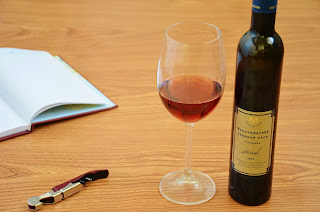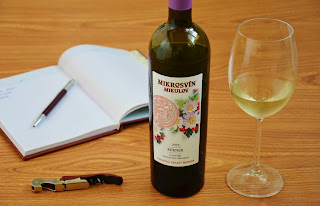In the Czech Republic there are three types of very sweet
wines – ice wine, straw wine or sweet botrytised wine (Trockenbeerenauslese).
Straw wine is a very sweet dessert wine with a taste similar to more famous ice
wine. Although it can seem easily to just dry the grapes, it requires lots of
knowledge and patience from the winemaker as the harvested grapes go bad very
easily like all fresh fruits. The best healthy grapes (this straw wine from
winery Marcincak is even produced in organic quality) are harvested at
must-weight of 27°ČNM and placed on straw or reed mats or
suspended on racks. The law requires minimum of 3 months drying, however this
winemaker uses 4-6 months of drying to get the highest possible sugar content.
Straw wine Blaufränkisch 2012
sweet
straw wine (Strohwein)
10,0% alc.
residual sugar: 205 g/l
acids: 8,2 g/l
Moravia region, Mikulov subregion, wine village Novosedly, vineyard Stara hora
This wine is rarely made of red grapes – most of the straw
or ice wine are made of white grapes in the Czech Republic. The grape variety
is Blaufränkisch (also called Lemberger) and it is the second most grown red
cultivar in the country. The grapes are typical for Central Europe, it is also
commonly used for other hybrids. It is a late variety, harvested as one of the
last approximately in the middle of October, therefore it needs the best slopes,
preferably with drier loess soils. Blaufränkisch wines have higher acidity than
other red wines, also the tannins are quite high and rough. However, the wine
is suitable for maturing in oak which helps to build full taste with spicy cinnamon
notes while keeping the distinctive fruity character of blackberries.
This straw wine comes from the Mikulov subregion, wine village
Novosedly, vineyard Stara hora which is 46 years old. The grapes were handpicked
on 18/12/2012. After drying they were pressed at must-weight level of 46°ČNM and matured in oak barrels for 1 year, then
further in the bottle. When pouring the wine in a glass, you will be definitely
amazed by the beautiful red-brown color with bright red glints. It has intense aroma
of candied red fruits, spices and honey. The palate is full, rich with smooth
fruity taste of sweet cherries, blackberries and plums with notes of spices,
vanilla and cinnamon with a long aftertaste. The rich sweetness (205 g/l of
residual sugar!) is balanced with a very good acidity thus the wine does not
feel mawkish, not cloying on the palate. It reminds of delicious plum
pie with cinnamon.
The wine is full-bodied, highly extractive, suitable to pair with
desserts or for contrast with aged blue cheese.
In our offer you can find
also white organic straw wine - Welschriesling 2012.
Follow Check
Czech Wine to get more reviews!
Follow our
Facebook: https://www.facebook.com/checkczechwine
View more
photos on our Instagram: https://www.instagram.com/checkczechwine/
Visit our website
to see wines we offer: http://www.winehills.eu




















